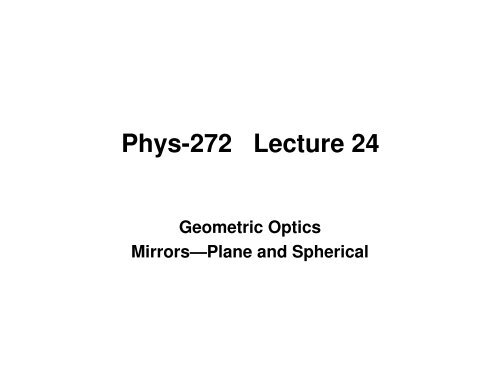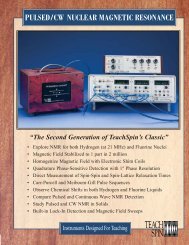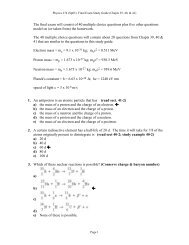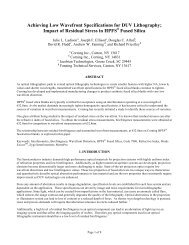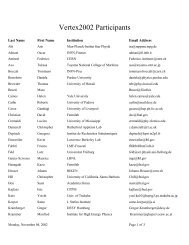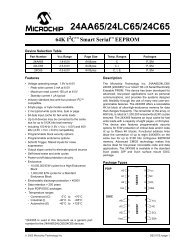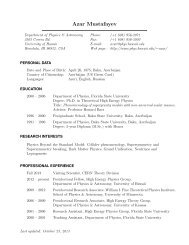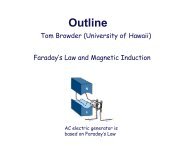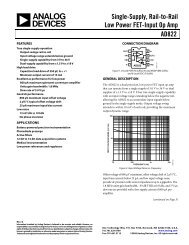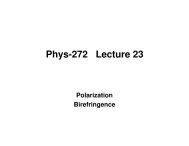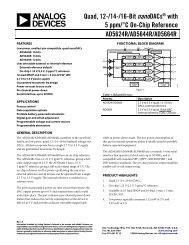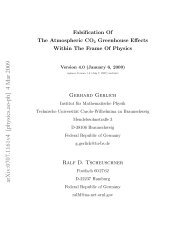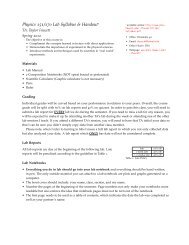You also want an ePaper? Increase the reach of your titles
YUMPU automatically turns print PDFs into web optimized ePapers that Google loves.
Phys-<strong>27</strong>2 <strong>Lecture</strong> 24<br />
Geometric Optics<br />
Mirrors—Plane and Spherical
+<br />
Hubble Space Telescope
Plane (Flat) Mirrors<br />
Already know physics:<br />
θ R = θ I<br />
Source: Object – emits rays<br />
in all directions.<br />
Eye intercepts cone of rays.
Plane Mirrors<br />
SIGN RULE convention for s and s′;<br />
• IF object & incoming ray same side, s pos., otherwise neg.<br />
• IF image & outgoing ray same side, s′ pos., otherwise neg.<br />
• IF curvature center & outgoing ray on same side, pos.,<br />
otherwise neg.<br />
For mirror example, we have s = -s′
Plane Mirrors
Flat Mirror<br />
(1) Draw first ray perpendicular to mirror 0 = θ i = θ r<br />
(2) Draw second ray at angle. θ i = θ r<br />
(3) Lines appear to intersect a distance d behind<br />
mirror. This is the image location.<br />
θ r<br />
θ i<br />
Virtual Image:<br />
No light actually gets here<br />
d<br />
d
Clicker<br />
A woman is looking at her reflection in a flat vertical mirror.<br />
The lowest part of her body she can see is her knee.<br />
CD<br />
If she stands closer to the mirror, what will be the lowest part of<br />
her reflection she can see in the mirror.<br />
A. Above her knee<br />
B. Her knee<br />
C. Below her knee
Clicker<br />
A woman is looking at her reflection in a flat vertical mirror. The lowest<br />
part of her body she can see is her knee. If she stands closer to the mirror,<br />
what will be the lowest part of her reflection she can see in the mirror.<br />
A. Above her knee<br />
B. Her knee<br />
C. Below her knee<br />
If the light doesn’t t get to your<br />
eye then you cant see it
Concave Mirrors<br />
Concave: Consider the case where the shape of the mirror is such<br />
that light rays parallel to the axis of the mirror are all “focused”<br />
to a common spot a distance f in front of the mirror:<br />
These mirrors are often<br />
sections of spheres<br />
(assumed in this class).<br />
f<br />
For such “spherical”<br />
mirrors, we assume all<br />
angles are small even<br />
though we draw them<br />
larger to easily see and<br />
understand…
Aside:<br />
For a spherical mirror, R = 2f<br />
R<br />
2f<br />
center of sphere<br />
sometimes labeled “C”<br />
f
Recipe for finding image:<br />
1) Draw ray parallel to axis reflection goes through focus<br />
2) Draw ray through focus reflection is parallel to axis<br />
3) Draw ray from object through radius = 2f, reflects back<br />
through 2f<br />
object<br />
2f<br />
image<br />
f<br />
You now know the position of the same point on the image
Ray tracing for a concave mirror<br />
h<br />
R-s’<br />
R<br />
θ<br />
θ<br />
s-R<br />
h’<br />
s’<br />
s
Spherical Mirror<br />
Concave Mirror<br />
Point C, center of curvature.<br />
Suppose object at P, then out<br />
Going ray passes through P’.<br />
α + θ = φ ; φ + θ = β ⇒ α + β = 2φ<br />
tanα<br />
=<br />
h<br />
s − δ<br />
;<br />
tan β =<br />
h h<br />
α ≅ β ≅ ;<br />
s s'<br />
h<br />
s'<br />
−δ<br />
Assume, angles small, δ ≅ 0,<br />
paraxial rays, approx. parallel<br />
to axis. Note s and s′ positive.<br />
h<br />
R<br />
;<br />
tanφ<br />
=<br />
h<br />
R − δ<br />
Mirror Equation:<br />
+ =<br />
; φ ≅ s s'<br />
R<br />
1<br />
1<br />
2
Spherical Mirror<br />
Infinite distance, s= ∞, s′=R/2<br />
image appears at ½ radius of<br />
curvature.<br />
1<br />
∞<br />
+<br />
1<br />
s'<br />
=<br />
2<br />
R<br />
Equation<br />
1<br />
s<br />
+<br />
1<br />
s'<br />
=<br />
2<br />
R<br />
Nomenclature; focal length,<br />
f=R/2, is image length when<br />
object is at infinity.<br />
1<br />
s<br />
+<br />
1<br />
s'<br />
=<br />
1<br />
f<br />
Real image – formed by converging rays. Can be viewed on screen.<br />
Virtual image – rays do not go through. Cannot be shown on screen.<br />
Concave mirror: can have real or virtual images.
Camera Region<br />
S >2f<br />
image is:<br />
real<br />
inverted<br />
smaller<br />
1 1 1<br />
+ =<br />
S S ′ f<br />
M = − S ′<br />
S<br />
object<br />
2f<br />
image<br />
f<br />
S<br />
S’<br />
f
Vanity Region<br />
f > S > 0<br />
rays no-longer meet<br />
in front of the mirror<br />
but they do meet<br />
behind the mirror<br />
f<br />
object<br />
image<br />
(virtual)<br />
f<br />
S
Lateral Magnification; spherical mirror<br />
θ =<br />
y<br />
s<br />
=<br />
|<br />
y′<br />
s′<br />
|<br />
Magnification =<br />
y '<br />
y<br />
= −<br />
s'<br />
s<br />
Remarks; note that y’=-|y’|, since the arrow is upside down and<br />
s, s’, and y are positive. So the magnification by this definition<br />
is negative, since y’ is upside down.
Examples of ray tracing for concave mirrors<br />
s>R<br />
image<br />
Inverted<br />
m=s’/s<br />
s=R<br />
m=-1<br />
s=R/2=f<br />
m=∞<br />
s1<br />
Cosmetic/”vanity” mirror
More examples<br />
s>R<br />
image<br />
Inverted<br />
m=s’/s<br />
s=R/2=f<br />
m=∞<br />
2<br />
1<br />
;<br />
15<br />
10<br />
30<br />
(10)(30)<br />
;<br />
30<br />
;<br />
1<br />
1<br />
1<br />
10<br />
2<br />
;<br />
20<br />
= −<br />
′<br />
−<br />
=<br />
=<br />
−<br />
=<br />
′<br />
=<br />
−<br />
=<br />
′<br />
=<br />
′<br />
+<br />
=<br />
=<br />
=<br />
s<br />
s<br />
m<br />
cm<br />
s<br />
cm<br />
s<br />
f<br />
s<br />
fs<br />
s<br />
f<br />
s<br />
s<br />
cm<br />
R<br />
f<br />
cm<br />
R<br />
= −∞<br />
′<br />
−<br />
=<br />
= ∞<br />
−<br />
=<br />
′<br />
=<br />
−<br />
=<br />
′<br />
=<br />
′<br />
+<br />
s<br />
s<br />
m<br />
s<br />
cm<br />
s<br />
f<br />
s<br />
fs<br />
s<br />
f<br />
s<br />
s<br />
;<br />
10<br />
10<br />
(10)(10)<br />
;<br />
10<br />
;<br />
1<br />
1<br />
1
Even more examples<br />
s=R<br />
m=-1<br />
s1<br />
cosmetic mirror<br />
1<br />
;<br />
20<br />
10<br />
20<br />
(10)(20)<br />
;<br />
20<br />
;<br />
1<br />
1<br />
1<br />
= −<br />
′<br />
−<br />
=<br />
=<br />
−<br />
=<br />
′<br />
=<br />
−<br />
=<br />
′<br />
=<br />
′<br />
+<br />
s<br />
s<br />
m<br />
cm<br />
s<br />
cm<br />
s<br />
f<br />
s<br />
fs<br />
s<br />
f<br />
s<br />
s<br />
2<br />
5<br />
10)<br />
(<br />
;<br />
10<br />
10<br />
5<br />
(10)(5)<br />
;<br />
5<br />
;<br />
1<br />
1<br />
1<br />
= +<br />
−<br />
= −<br />
′<br />
−<br />
=<br />
= −<br />
−<br />
=<br />
′<br />
=<br />
−<br />
=<br />
′<br />
=<br />
′<br />
+<br />
s<br />
s<br />
m<br />
cm<br />
s<br />
cm<br />
s<br />
f<br />
s<br />
fs<br />
s<br />
f<br />
s<br />
s
Convex<br />
mirror<br />
For a convex mirror, the radius of curvature is inside the<br />
mirror. We have another RULE, that when the curvature<br />
center C is on the same side of the outgoing ray, then the<br />
radius is positive. For the convex mirror we have NEGATIVE<br />
radius. Also from our rule for s’, we observe this is negative in<br />
the above drawing. Using same recipe as we used for concave<br />
mirrors, we would find same formula:<br />
1<br />
s<br />
+<br />
1<br />
s'<br />
=<br />
2<br />
R<br />
Again, note s’ and R are negative<br />
Magnification =<br />
(this is positive)<br />
y '<br />
y<br />
s'<br />
= −<br />
s
Convex: Consider the case where the shape of the mirror is such<br />
that light rays parallel to the axis of the mirror are all “focused”<br />
to a common spot a distance f behind the mirror:<br />
f
Christmas Tree Ornament, Mirrors in 7-11’s<br />
Convex mirror, R & s’ negative<br />
Santa is 75cm from convex mirror of radius 3.6cm. What is image position and magnification?<br />
s' = −1. 76cm<br />
1<br />
s<br />
+<br />
1<br />
s'<br />
=<br />
2<br />
R<br />
=<br />
1<br />
75<br />
+<br />
1<br />
s'<br />
=<br />
−<br />
2<br />
3.6<br />
s'<br />
m = − s<br />
= −<br />
−<br />
1.76<br />
75<br />
=<br />
.0234
Another striking example:
Quick Clicker<br />
2) The diagram below shows<br />
three light rays reflected off<br />
of a concave mirror. Which<br />
ray is NOT correct?<br />
A)<br />
C)<br />
R<br />
B)<br />
f<br />
A)<br />
B)<br />
C)
Multi-part clicker<br />
I). The image produced by a concave mirror of a real object is<br />
a) always real.<br />
b) always virtual.<br />
c) sometimes real<br />
and sometimes virtual.<br />
II). The image produced by a concave mirror of a real object is<br />
a) always upright.<br />
b) always inverted.<br />
c) sometimes upright<br />
and sometimes inverted.
Is image of a real object from a concave mirror<br />
real or virtual?<br />
It depends on the position of the object relative to the focal point!<br />
• Draw Rays or..<br />
• 1/s’ = 1/f – 1/s (concave implies f > 0)<br />
Is image of a real object from a concave mirror<br />
upright or inverted?<br />
Once again, it depends on position relative to focal point!<br />
• If s’ > 0, real and inverted<br />
• If s’ < 0, virtual and upright
I). The image produced by a convex mirror of a real object is<br />
a) always real.<br />
b) always virtual.<br />
c) sometimes real<br />
and sometimes virtual.<br />
II). The image produced by a convex mirror of a real object is<br />
a) always upright.<br />
b) always inverted.<br />
c) sometimes upright<br />
and sometimes inverted.<br />
BTW has the side mirror<br />
on your car ever produced<br />
an upside-down image of<br />
the world when your car<br />
was still upright? If so,<br />
get a new car.
Is image of a real object from a convex mirror<br />
real or virtual?<br />
Same PROCEDURE as for concave mirrors we did earlier!<br />
• Draw Rays or..<br />
• 1/s’ = 1/f – 1/s (convex implies f < 0)<br />
Is image of a real object from a convex mirror<br />
upright or inverted?<br />
Once again, depends on sign of s’ (real/inverted or virtual/upright)<br />
• Here s’ < 0 ALWAYS… therefore virtual and upright
Clicker problem<br />
• In order for a real object to create a real, inverted enlarged image,<br />
a) we must use a concave mirror.<br />
b) we must use a convex mirror.<br />
c) neither a concave nor a convex mirror can produce this image.
Clicker problem<br />
• In order for a real object to create a real, inverted enlarged image,<br />
a) we must use a concave mirror.<br />
b) we must use a convex mirror.<br />
c) neither a concave nor a convex mirror can produce this image.<br />
• A convex mirror can only produce a virtual image since all reflected<br />
rays will diverge. Therefore, b) is false.<br />
• To create a real image with a concave mirror, the object must be<br />
outside the focal point.<br />
• The example we just did gave a real,<br />
inverted reduced image.<br />
• Is it possible to choose the parameters<br />
θ<br />
such that the image is enlarged?? h<br />
θ<br />
The easy (but clever) answer:<br />
• h’ is a real image.<br />
• Therefore consider the OBJECT to be<br />
h’. The IMAGE will be h !!!<br />
• Therefore it certainly IS POSSIBLE!!<br />
equations follow…<br />
s-R<br />
R-s’<br />
s<br />
h’<br />
R<br />
s’
Clicker problem<br />
• In order for a real object to create a real, inverted enlarged image,<br />
a) we must use a concave mirror.<br />
b) we must use a convex mirror.<br />
c) neither a concave nor a convex mirror can produce this image.<br />
• The example we just did gave a real,<br />
inverted reduced image.<br />
• Is it possible to choose the parameters<br />
such that the image is enlarged??<br />
1 1 1<br />
+ =<br />
fs<br />
s′<br />
=<br />
s s′<br />
f<br />
s − f<br />
M<br />
=<br />
−<br />
s′<br />
s<br />
M<br />
f<br />
= −<br />
s − f<br />
Thus to get a real image we need:<br />
s ><br />
Thus to get an inverted enlarged image we need:<br />
h<br />
s-R<br />
Thus to get a real, inverted enlarged image we need:<br />
f<br />
R-s’<br />
s < 2<br />
f<br />
s<br />
h’<br />
R<br />
f < s < 2 f<br />
θ<br />
θ<br />
s’
Keck telescope on the<br />
top of Mauna Kea<br />
(13,600 ft)<br />
Two 10m (33 ft)<br />
diameter mirrors;<br />
focal length 17.5<br />
m
Mirror for the Hubble space telescope (f =57.6 m)
<strong>Lecture</strong> End<br />
BACKUP SLIDES
Avoid the distortion and<br />
bandwidth limitations of<br />
the earth’s atomsphere.
Artificat of<br />
CCD camera<br />
Eagle Nebula viewed by the Hubble
A field of galaxies viewed by the Hubble<br />
Gravitational<br />
lensing
Executive Summary - Mirrors:<br />
S > 2f<br />
2f > S > f<br />
real<br />
inverted<br />
smaller<br />
real<br />
inverted<br />
bigger<br />
concave<br />
(converging)<br />
f<br />
f > S > 0<br />
virtual<br />
upright<br />
bigger<br />
1 1 1<br />
+ =<br />
S S ′ f<br />
M = − S ′<br />
S<br />
S > 0<br />
virtual<br />
upright<br />
smaller<br />
convex<br />
(diverging)<br />
f
S = 2f<br />
image is:<br />
real<br />
inverted<br />
same size<br />
1 1 1<br />
+ =<br />
S S ′ f<br />
M = − S ′<br />
S<br />
object<br />
f<br />
image<br />
2f<br />
S’<br />
S<br />
f
2f > S > f<br />
image is:<br />
real<br />
inverted<br />
bigger<br />
1 1 1<br />
+ =<br />
S S ′ f<br />
M = − S ′<br />
S<br />
2f<br />
object<br />
f<br />
image<br />
S’<br />
S<br />
f
f > S > 0<br />
image is:<br />
virtual<br />
upright<br />
bigger<br />
1 1 1<br />
+ =<br />
S S ′ f<br />
M = − S ′<br />
S<br />
f<br />
object<br />
image<br />
(virtual)<br />
f<br />
S<br />
S’
convex<br />
f<br />
The size is the only thing that changes<br />
with a convex mirror, it is always<br />
virtual and upright.
An arrow is located in front of a convex<br />
spherical mirror of radius R = 50cm.<br />
The tip of the arrow is located<br />
at (-20cm, 20cm,-15cm).<br />
(-20, 20,-15)<br />
y<br />
R=50<br />
x<br />
Where is the tip of the arrow’s s image?<br />
• Conceptual Analysis<br />
• Mirror Equation: 1/s + 1/s’ = 1/f<br />
• Magnification: M = -s’/s<br />
• Strategic Analysis<br />
•Use mirror equation to figure out the x coordinate of the image<br />
•Use the magnification equation to figure out the y coordinate of the<br />
tip of the image
An arrow is located in front of a convex<br />
spherical mirror of radius R = 50cm.<br />
The tip of the arrow is located<br />
at (-20cm, 20cm,-15cm).<br />
(-20, 20,-15)<br />
y<br />
R=50<br />
x<br />
What is the focal length of the mirror?<br />
A) f =50cm B) f = 25cm C) f = -50cm D) f = -25cm<br />
For a spherical mirror | f | = R/2 = 25cm.<br />
Rule for sign: Positive on side of mirror where light goes after hitting mirro<br />
y<br />
R<br />
f = - 25 cm<br />
f<br />
< 0
An arrow is located in front of a convex<br />
spherical mirror of radius R = 50cm.<br />
The tip of the arrow is located<br />
at (-20cm, 20cm,-15cm).<br />
y<br />
R=50<br />
f = -25 cm<br />
x<br />
(-20, 20,-15)<br />
What is the x coordinate of the image?<br />
A) 11.1 cm B) 22.5 cm C) -11.1 cm D) -22.5cm<br />
Mirror<br />
equation<br />
1 1 1<br />
= −<br />
s′<br />
f s<br />
fs<br />
s′ = s = 20 cm<br />
s − f f = -25 cm<br />
( −25)(20)<br />
s′ =<br />
= -11.1 cm<br />
20 + 25<br />
Since s’ s < 0 the image is virtual (on the “other” side of the mirror)
An arrow is located in front of a convex<br />
spherical mirror of radius R = 50cm.<br />
The tip of the arrow is located<br />
at (-20cm, 20cm,-15cm).<br />
y<br />
R=50<br />
x = 11.1 cm<br />
f = -25 cm<br />
x<br />
(-20, 20,-15)<br />
What is the y coordinate of the tip of the image?<br />
A) -11.1 cm B) -10.7 cm C) -9.1 cm D) -8.3cm<br />
Magnification<br />
equation<br />
M = − S ′<br />
S<br />
s = 20 cm<br />
s’ = -11.1 cm<br />
M = 0.556<br />
y image = 0.55 y object = 0.556*(-15 cm) = -8.34 cm
Ray Tracing or Graphical techniques<br />
Useful to help describe image.<br />
To find the image position in<br />
Practice we need to find the<br />
Intersection of at least<br />
two rays. Useful rays are<br />
1) Focal point F, #2<br />
2) Ray through C, #3<br />
3) Vertex V, #4<br />
4) Parallel ray reflects<br />
through F, #1
S > 0<br />
image is:<br />
virtual<br />
upright<br />
smaller<br />
1 1 1<br />
+ =<br />
S S ′ f<br />
object<br />
image<br />
(virtual)<br />
f0 S’


